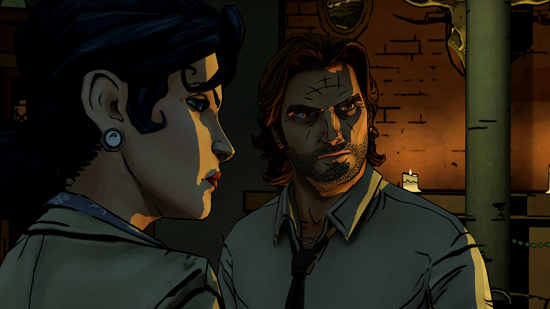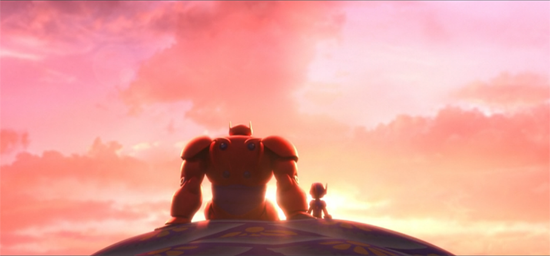Submitted by Scott Garbacz on Tue, 04/28/2015 - 17:53
Submitted by Scott Garbacz on Tue, 04/21/2015 - 16:42
Submitted by Scott Garbacz on Sat, 04/04/2015 - 17:34
 Image source: N3rdabl3.co.uk.
Image source: N3rdabl3.co.uk.
Earlier this semester, I discussed the way Once Upon a Time, particularly in its first season, played with Disney-inspired costuming to evoke nostalgia for Disney-tinged fairytales even as it valorized the present over the past. As a follow-up, and as Viz moves towards consideration of video games, I want to look at a more recent work with similar themes: the critically acclaimed fairy-tale-noir adventure game, The Wolf Among Us. In this game, the player takes on the role of a reformed Big Bad Wolf (known, now, as Bigby), who solves a series of gruesome mysteries with the help of his potential love-interest, Snow White. Specifically, I will look at three costumes associated with Snow. Like those worn by Once’s Snow White, these costumes each present a different way in which we can view the past. Unlike those in Once, these costumes trouble any clear distinction between our modern lives and the medieval-themed fairy tales that underwrite them. Instead of encouraging us to celebrate our modernity, The Wolf Among Us troubles our neat divisions between the present and the past, asking us how we use the past to think about, or act in, the present. (Content Warning: the discussion below, like the game, deals with prostitution and disturbing sexual power dynamics.)
Submitted by Scott Garbacz on Sun, 03/29/2015 - 13:31
 Image screen-captured from Disney Movies Anywhere.
Image screen-captured from Disney Movies Anywhere.
Last week, I discussed the ways Guardians of the Galaxy mixes a more-or-less serious story of grief and community formation with a gleefully irresponsible sense of violence and adventure. While I emphasized the way these two themes contrast with each other, in reality they work together in the cause of big-screen popcorn entertainment. The story of Quill’s quest to acknowledge and accept the death of his mother provides a certain emotional grounding to the story’s rather silly violence, while the gleeful immaturity of the overall narrative lessens the sting of its brush with seriousness. This week, I want to turn to the kids’ movie version of Guardians of the Galaxy: Big Hero 6. Both share not only their Marvel-produced heritage, but also an odd interest in fatherlessness, the psychological roots of violence, and the process of grief. The most surprising element of Big Hero 6, however, is how much more seriously it takes these issues than Guardians of the Galaxy; its handling of grief, mourning, and violence indeed open up more general critiques both of the superhero genre and of the desires that make it popular. (Obviously, spoilers follow.)
Submitted by Scott Garbacz on Tue, 03/24/2015 - 15:08
Submitted by Scott Garbacz on Tue, 03/03/2015 - 17:43
Submitted by Scott Garbacz on Tue, 02/24/2015 - 14:25
 Image screen captured from abc.go.com.
Image screen captured from abc.go.com.
Fantasy is in vogue these days; even sometimes finding its way to the fashion runway. Admittedly, its big-screen run is nearing the end. The decade-long Harry Potter series came to an end in 2011, while the latest Hobbit movie marks the end of Peter Jackson’s The Lord of the Rings decade (extended cut, 2001-2014). Yet while big-budget blockbusters has been taken over by superhero movies or science-fiction dystopias, 2011 saw the advent of two small-screen franchises: the HBO epic fantasy series Game of Thrones and the network hit that is currently Netflix’s second most popular show, the fairy-tale drama Once Upon a Time. Game of Thrones, of course, has been the subject of many academic discussions and controversies; here, it has already been covered excellently on this site from the perspective of visual narrative theory, internet-enabled reader-response “marginalia," and even the tradition of opening films and television episodes with horses, and has had an excellent write-up of the ways its fashion stages culturally situated arguments about gender. Expanding upon Deb's comment yesterday that costumes are always making an argument, I want to look at the way that Once Upon a Time uses costumes to navigate the tension between our sense of the vibrancy of our present day lives and our collective desires for the past, especially as filtered through the lens of childhood memories.
Read more about Fashioning Modernity in Once's Urban Fairy-Tale
Submitted by Scott Garbacz on Tue, 02/17/2015 - 21:32

Image Credit: SI.com
In a sport known for its trash talk, boastfulness, and elaborately arcane jargon, Marshawn Lynch’s mouth is the exception. Whether wearing a distinctive mask or remaining taciturn in interviews, one of the world’s greatest rushers has made a name for himself precisely be keeping his mouth closed. This reticence—as well as his resultant struggles with the NFL powers-that-be—that makes him a fascinating icon of our current trust in fitness as a source of security in a very economically uncertain time.
Submitted by Scott Garbacz on Mon, 02/02/2015 - 14:38
Note: the following blog was slated to be published last week, but due to technical difficulties got pushed back a week. While I considered going with more topical material this week, I decided ultimately that it would be tragic if the Viz blog ignored the wonders of Left Shark, not to mention Marshawn Lynch's ironic relation to the culture of extreme fitness.
Read more about The Super Bowl, Visual Rhetoric, and Marshawn's Mask